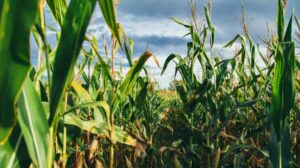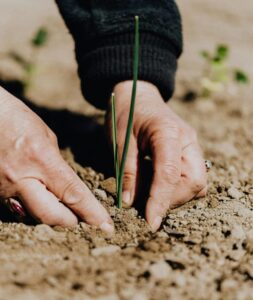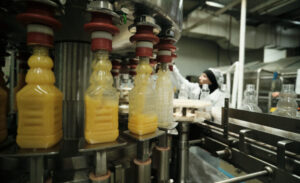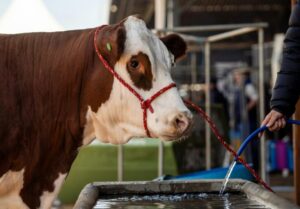Introduction
“Weather remains a primary driver of agribusiness confidence and growth in agriculture”, Wandile Sihlobo (Agbiz)
South Africa is a relatively dry country. The climate varies from desert to semi-desert in the west, to relatively wet in the eastern parts adjacent to the Indian Ocean. Compared to the rest of the world, this country has a very low average rainfall – 470mm per year, which is only half of the world average.
South Africa’s rainfall is typically unreliable and unpredictable. South Africa is periodically afflicted by drastic and prolonged droughts, which often end in severe floods. There are several explanations for the variable rainfall. One reason is related to the oceans around the country. Another is linked to our position in the global weather and climate systems. For example, we receive some rainfall from warm, moist air that sweeps down over the country from the North- West. In the South Western parts of the country, cold fronts usually bring winter rainfall. La Niña and El Niño also influence our rainfall from time to time.
Because of the topography as well as the rainfall distribution, 60% of South Africa’s run-off water is in rivers that flow through only 20% of the country (the eastern region). Most of our clouds are caught up by the Drakensberg mountain range in the east where precipitation occurs. This water then runs down the steep side of the Drakensberg and into rivers of KwaZulu-Natal and into the sea.
On average, only some 9% of rainfall reaches the rivers.
The country falls squarely within the subtropical belt of high pressure, making it dry, with an abundance of sunshine.
Weather
- Weather is the condition of the atmosphere at a specific time, or over a very short period of time, at a place.
- It is described by various observed meteorological phenomena and measured elements (including atmospheric pressure, temperature, humidity, precipitation, cloudiness and wind speed as well as wind direction).
Many day-to-day decisions of farmers depend on current weather conditions and how it will change over the next few days, weeks or months.
Climate
- The average condition of the atmosphere at a place or in a region as observed over a period of at least 30 years.
- This average condition, or the climate, is usually described in terms of temperature, precipitation and wind.
The climate of a place will determine what crops will succeed best in a specific region, or what animals will best suit a specific region.
Agrometeorology
Agrometeorology studies the influence of climate and weather on agricultural production. As South Africa’s seasonal climate is highly variable and precarious, climate is a deciding factor in successful agricultural production.
The weather patterns have changed
At the moment, there are two fundamental aspects that seem to underpin the weather factor in South Africa’s agricultural sector.
- The country now receives average annual rainfall that is lower compared to past trends. In past decades, South Africa received an average of 526 millimetres of rainfall per year. The post-2010 annual rainfall has averaged 7% lower compared to the previous three decades (1970-2010).
- The geographic and temporal distribution of rainfall seems to have shifted over time. Anecdotal evidence suggests a delay in the onset of the summer season. Recent rainfall patterns have seen a three-to-six-week delay, which translates to a shift in optimal planting dates for summer grain and oilseed, and subsequently the maturing periods.
These weather shifts have been a continuous challenge for farmers in terms of planning the planting periods so they can coincide with peak rainfall patterns in order for crops to receive sufficient moisture for seed germination and crop development.
Extracted from “Changing weather patterns a challenge for farmers” by Wandile Sihlobo, chief economist at Agbiz. Find the whole article at https://wandilesihlobo.com/2019/02/21/changing-weather-patterns-a-challenge-for-farmers/.
What to do in times of drought
Live stock farmers can consider the following actions to mitigate the effect of drought:
- Divide your herd into production classes e.g. in calf, lactating, heifers, young bulls, oxen, etc.
- Restrict the movement of animals in order to conserve energy.
- Move animals to shaded/warmer areas where they can be fed.
- Make sure animals are healthy.
- Use the available grazing and other fodder sources to good judgement between different production classes.
- Always give priority to the most vulnerable animals e.g. with small calves etc.
- Decrease rations of non-producing animals by providing smaller portions daily or every other day a full portion.
- Non-productive animals easily can handle a drop in mass of 10-12% over a long period of time.
- Use expert advice in order to utilise available fodder to a maximum e.g. Smaller portions but well balanced to fill needs of different production classes better.
- Think creatively by using residues like fowl droppings (make sure animals are vaccinated against botulism), grain siftings, etc.
- Use well-balanced rations and keep to the recommendations of suppliers, and beware of over feeding – it is expensive.
- Try not to change rations too often but keep it constant and simple. The digestive system of an animal must adapt to new substances or ratios with every change.
Source: Dr Herman Fouchè and Mr Johan van den Berg in an article originally printed in Landbouweekblad. Find other articles under the "Websites & publications" heading.
An example follows of strategies that have appeared on the DALRRD monthly advisories, given the prevailing climatic/weather conditions. In this case, below normal rainfall i.e. dry conditions were expected.
- Rain-fed crop production:
- remove alien plants
- adjust planting density
- consider a conservative fertilising strategy
- do regular and strict scouting for pests and diseases to minimise expenditure on chemical control
- do not expand land under crop production unnecessarily
- do not experiment with the new and unknown and avoid unnecessary capital investments
- store water in wetlands and dams
- reduce evaporation
- encourage infiltration of storm water runoff
- Stock farming
- remove alien plants
- spread water points evenly through grazing areas
- first graze areas where vegetation already shed leaves
- plant hardy trees/shrubs for browse
- keep well-adapted breeds of livestock
- provide suitable licks and make dry range grasses palatable
- when conditions worsen, take animals to the camps and feed them
- wean early and raise young animals intensively
- postpone the mating period during extremely dry conditions
- market surplus stocks and cull poor producers when feed resources run out
- maintain young best females
- control stock numbers to prevent overgrazing and to save the veld for the coming winter season
- control animal diseases and parasites
- feed pregnant and lactating animals better
- evaluate carrying capacity of their available grazing and apply the appropriate stocking rates accordingly
- Dryland farming
- remove alien plants
- remove all weeds containing seeds, but keep other vegetative rests on the land because that will reduce evaporation
- obtain the desired seeds for the crops to be planted
- check and repair all tools and machinery
- consider the making of bunds or other features to increase infiltration and to reduce run off
- irrigate during cool conditions to avoid evaporation adhere to the water restrictions at all times as the levels of earth dams deteriorate in most areas
International business environment
- International Research Institute for Climate and Society, http://iri.columbia.edu
- The World Meteorological Organisation (WMO) is an agency of the UN, established in 1950. Visit www.wmo.int.
- International weather forecasts may be accessed www.metoffice.gov.uk/weather.
- The USA Department of Agriculture website has a “Weather & Climate” option. Clicking on the “Publications/Reports” will give you inter alia “World Agricultural Weather Highlights”. Visit www.usda.gov/oce/weather.
- GEOGLAM (Group on Earth Observations Global Agricultural Monitoring ) is an initiative to “strengthen global agricultural monitoring by improving the use of remote sensing tools for crop production projections and weather forecasting”. See www.geoglam.org.
National strategy and government contacts
Inclement weather has a negative effect on the objectives of government’s National Development Plan to create a million jobs in agriculture by 2030.
- Department of Cooperative Governance and Traditional Affairs (CoGTA) South African National Disaster Management Centre www.ndmc.gov.za
- Department of Agriculture Climate Change and Disaster Management Tel: 012 319 6775/ 6794 Assistant Manager (Agro-Meteorologist): Early Warning Unit, Tel: 012 319 6768 The Directorate compiles the monthly advisories which have the strategies for farming community to apply given the current climate conditions. These are available at www.nda.gov.za.
- Department of Forestry, Fisheries and the Environment (DFFE) www.dffe.gov.za
- Department of Water & Sanitation (DWS) www.dws.gov.za
- SA Weather Service (SAWS) www.weathersa.co.za SAWS, a parastatal government organisation, falls under the auspices of Minister of DFFE. It is governed by a Board, which reports to the said Minister. It is a member of the World Meteorological Organisation and serves on its Executive Council. SAWS is ISO 9001:2008 certified for the provision of meteorological and climatological products and services, provides scientific training in co-operation with universities, as well as an NQF5 certified Weather Observer Certificate.
Role players
View the Premium Listings below (scroll down or click on “Premium Listings” on the Table of Contents to the right).
Further reference:
Read about Rain for Africa (R4A), a project between several partners including the Dutch government, the ARC and the SA Weather Service to provide the best possible weather information so as to reduce input costs by 10% and increase income by 10%. See www.rain4africa.org.
Websites and publications
Refer to the websites listed earlier on this page. The website of the South African Weather Service, for example, can be accessed at www.weathersa.co.za.
- Du Pisani L. 2019. Slim Droogtebestuur vir Veeboere (Smart Drought Management for Livestock Farmers). Krugersdorp: Kejafa
- http://droogterampfonds.co.za and http://droughtaidfund.co.za, the Drought Disaster Fund run by Agri SA. Watch the Agri SA video on the drought in South Africa here.
- Websites of companies involved with agriculture usually have some menu option to do with weather e.g. www.landbou.com and www.senwes.co.za.
- Visit www.weatherphotos.co.za if you need information or photos of weather patterns, satellite photos or daily rainfall graphics.
- Read AgriSeker‘s Cumulus magazine at www.agriseker.co.za
- The monthly Food Security Bulletin from the Department of Agriculture includes a report on the weather. Find it at www.nda.gov.za.
- A monthly climate and vegetation monitoring newsletter, Umlindi (“the watchman” in Zulu), can be subscribed to. Find it at www.arc.agric.za.
- www.netfor.co.za – Weather forecasting for South Africa. Menu options include Two Day Forecast as well as current weather and graphical presentations.
- The Norwegian website www.yr.no can provide a weather forecast for your farm.
- The Best practice reference manual for wool sheep farming in South Africa, available in English and Afrikaans, includes useful notes on managing your flock in times of drought. Find the document on www.capewools.co.za and www.nwga.co.za.
- Contact Kejafa Knowledge Works for publications on weather and climate. This includes Du Pisani’s 2019 Smart Drought Management for Livestock Farmers (also available in Afrikaans). Visit www.kejafa.com or call 014 577 8006.
- Visit http://awnbooks.co.za for the following publications: (i) Weather & Climate Southern Africa (Tyson & Preston-Whyte) (ii) SA Weather and Atmospheric Phenomena (van Zyl) (iii) Dictionary of the weather (Dunlop) (iv) SASOL Field Guide to the Weather in Southern Africa
- Department of Agriculture, Forestry and Fisheries. 2016. Impact of Drought on Crop Production and the Food Value Chain. Available at goo.gl/cw59vG
Some articles
- Read our blog “Preparing for the Impending El Niño Drought: Strategies for South African Farmers” and “Four steps to weatherproofing your livestock farm“.
- Sihlobo W. 2024, May 8. “An end to El Niño and likely return of La Niña is positive for SA agriculture”. Daily Maverick. Available at www.dailymaverick.co.za/opinionista/2024-05-08-an-end-to-el-nino-and-likely-return-of-la-nina-is-positive-for-sa-agriculture/
- Stoddard E. 2024, April. “El Niño has ended but the full wrath of its economic and social impact is still to come”. MSN. Available at www.msn.com/en-za/news/other/el-ni%C3%B1o-has-ended-but-the-full-wrath-of-its-economic-and-social-impact-is-still-to-come/ar-BB1lJyvA
- Arnoldi M. 2024, April 17. “African Risk Capacity to pay out insurance to drought-affected Southern African farmers”. Polity. Available at www.polity.org.za/article/african-risk-capacity-to-pay-out-insurance-for-to-drought-affected-southern-african-farmers-2024-04-17
- Sihlobo W. 2024, February 26. “Current heat and scant rains are worrying for SA agriculture”. Business Day. Available at www.businesslive.co.za/bd/opinion/2024-02-26-wandile-sihlobo-current-heat-and-scant-rains-are-worrying-for-sa-agriculture/
- Rall S-A. 2024, January 4. “Two workers killed in lightning strike at KwaZulu-Natal farm”. IOL. Available at www.iol.co.za/news/south-africa/kwazulu-natal/two-workers-killed-in-lightning-strike-at-kwazulu-natal-farm-94322d6f-ba0d-4c6b-8c04-60e4f4a6c07d
- Pringle J. 2022, April 20. “Early warnings for floods in South Africa: engineering for future climate change”. The Conversation. Available at https://theconversation.com/early-warnings-for-floods-in-south-africa-engineering-for-future-climate-change-181556
- Ongoma V. 2022, February 1. “The science of weather forecasting: what it takes and why it’s so hard to get right”. The Conversation. Available at https://theconversation.com/the-science-of-weather-forecasting-what-it-takes-and-why-its-so-hard-to-get-right-175740
- Latham B. 2020, December 4. “Water stress affects more than 80% of SA cropland”. Farmer’s Weekly. Available at www.farmersweekly.co.za/agri-news/south-africa/water-stress-affects-more-than-80-of-sa-cropland/
- Dean S. 2019, November 1. “Feeding cattle during and after a drought”. Farmer’s Weekly. Available at www.farmersweekly.co.za/animals/cattle/feeding-cattle-during-and-after-a-drought/
- Sihlobo W. 2019, August 7. “Weather holds cards for agricultural sector”. Agbiz. Available at https://agbiz.co.za/uploads/AgbizNews19/190807_Weather%20holds%20cards%20for%20agricultural%20sector_Sihlobo.pdf
- Kalaba M.2019, March 6. “How droughts will affect South Africa’s broader economy”. The Conversation. Available at https://theconversation.com/how-droughts-will-affect-south-africas-broader-economy-111378
- Sihlobo W. 2019, February 21. “Changing weather patterns a challenge for farmers”. Available at https://wandilesihlobo.com/2019/02/21/changing-weather-patterns-a-challenge-for-farmers/
- De Waal H.O. 2019, Februarie 6. “Droogtewenke: Rek so jou weiding” [Tips for drought: utitise your grazing like this]. Landbouweekblad. Available at www.netwerk24.com/landbou/kundiges/vraag/Droogtewenke-Rek-so-jou-weiding-20190206
- Newswire. 2018, November 27. “Treasury loses out on more than R1bn in VAT from drought-stricken farmers”. Engineering News. Available at www.engineeringnews.co.za/article/treasury-loses-out-on-more-than-r1bn-in-vat-from-drought-stricken-farmers-2018-11-27/rep_id:4136
- Du Preez J. 2017, November 17. “Job losses in dry Western Cape now at 100 000”. Farmer’s Weekly.
- Branson A. 2017, September 18. “Drought Tolerant Fruit Tree Plants That Can Grow in Dry Climates”. Wilderners. Available at http://wilderners.com/drought-tolerant-fruit-tree/
- Find the article “Feeding management in Drought years” by JH Hoon (GADI) at https://gadi.dalrrd.gov.za/articles/Agric/zsap.php
Useful numbers
Climate Information and data Tel: 082 233 8484
Pretoria Central Forecasting Office Tel: 082 233 9800






